Kabbalah Ancient Egyptian Hebrew Talmudic Wisdom for Today Tarot Tree of Life
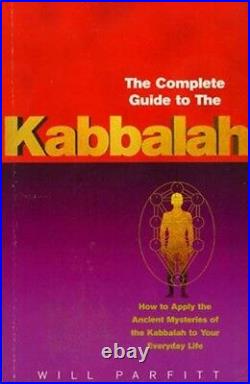
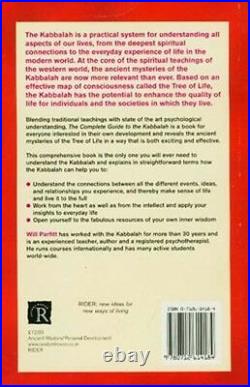
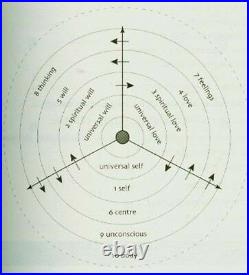
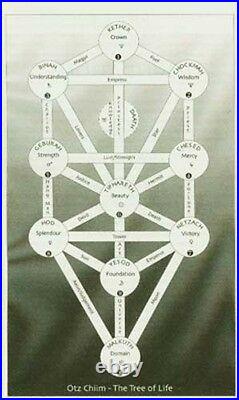
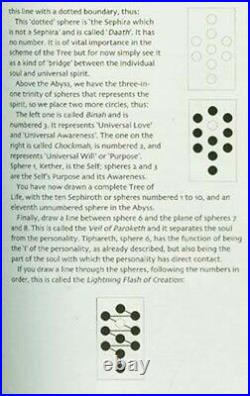

The Complete Guide to the Kabbalah: How to Apply the Ancient Mysteries of the Kabbalah to your Everyday Life. NOTE : We have 75,000 books in our library, almost 10,000 different titles. Odds are we have other copies of this same title in varying conditions, some less expensive, some better condition.
We might also have different editions as well (some paperback, some hardcover, oftentimes international editions). We're happy to send you a summary of the differing conditions and prices we may have for the same title. Dimensions: 9¼ x 6¾ x ¾ inch, 1 pound.
"The Complete Guide to the Kabbalah" clearly explains this ancient system of knowledge and how it can be effectively applied to our lives today. The Kabbalah is a practical system for understanding all aspects of our lives, from the deepest spiritual connections to the everyday experience of living in the modern world. At the core of the spiritual teachings of the Western world, the ancient mysteries of the Kabbalah are now more relevant than ever. Based on an effective map of consciousness called the Tree of Life, the Kabbalah has the potential to enhance the quality of life for individuals as well as the societies in which they live.
Blending traditional teachings with state-of-the-art psychological understanding, "The Complete Guide to the Kabbalah" is a book for everyone interested in their own development reveals the age-old mysteries of the Tree of Life in a way that is both exciting and effective. This comprehensive book is the only one you will ever need to understand the Kabbalah and explains in straightforward terms how the Kaballah can help you to understand the connections among all the different events, ideas, and relationships you experience in your life, and thereby make sense of life and live it to the fullest.. It will help you understand how to work from the heart as well as from the intellect, and to apply your insights to everyday life. And it will help you open yourself to the fabulous resources of your own inner wisdom.
New (albeit mildly "shopworn") oversized softcover. It's new and unread, BUT shows faint edge and corner shelfwear consequence of sitting unsold on a book store bookshelf for several decades. Pages are pristine; clean, crisp, unmarked, unmutilated, tightly bound, unambiguously unread.
Shelfwear is in the form of a very faint crinkling and abrasive rubbing to the open corners (top and bottom) of both the front and back covers. It's only easily discerned upon close scrutiny, and really even then only if you hold the book up to a light source and examine it in the reflected light. Just what you'd expect of a softcover book which sat unread and unsold on a bookshelf for 30 years. No eyesores such as tears or creases. Likewise if you hold the book up to a light source and intently scrutinize the front cover you can see where a book store price sticker was once adhering to the front cover near the upper open corner. There's an area where evidently the glue of the sticker pulled off the clear plasticine layer which overlayed the cover. Again it's really not noticeable unless you hold the book up to a light source (yeah, we're nitpicking) and examine it intently. PLEASE SEE IMAGES BELOW FOR SAMPLE PAGES FROM INSIDE OF BOOK. PLEASE SEE PUBLISHER, PROFESSIONAL, AND READER REVIEWS BELOW.REVIEW: The Kabbalah is a collection of teachings that date back to the ancient Egyptians and which offers an explanation of who we are, why we are here, and how we can make the best of ourselves and our lives. It has had a tremendous influence on Western thought. Leonardo da Vinci and Shakespeare used it.
Even the founding fathers of the United States were influenced by it. More recently, famous psychologists such as Freud and Jung were drawn to it and today, stars like Madonna, Jerry Hall and Kirk Douglas have all expressed their interest in the wisdom it has to offer. The Kabbalah is a very straightforward and logical system to learn. It is also a very practical system and can be used for self-help and personal development, intellectual understanding and spiritual growth. Kabbalistic teachings can be easily and genuinely applied to all areas of your life for deeper understanding, problem solving and generally enhanced appreciation of whatever issues are currently on your mind. The teachings are summarized in a diagram called the Tree of Life which presents visually the information accessible through the Kabbalistic teachings and reveals incredible patterns of connections that explain previously misunderstood areas. The Kabbalah has successfully helped thousands of people over thousands of years to understand themselves and every aspect of their lives and is an indispensable source of wisdom and practical, relevant knowledge. "The Complete Guide to the Kabbalah" by Will Parfitt is the only book you will ever need to understand and use the Kabbalah effectively in your daily life. Will is a registered psychotherapist who is well-known as an inspiring and innovative group course leader.He has been a student of the Kabbalah for more than thirty years, and has taught the Kabbalah for twenty years. Will is the director of several distance education courses including the Kabbalah and the Tree of Life.
He has published many articles in his field, and is the author of several books. Will has extensive experience of working with psycho-spiritual development, and he travels internationally to run courses on a variety of subjects, including both the Kabbalah and Psychosynthesis in which he completed training in 1981. He lives in Glastonbury where he offers coaching, mentoring and professional supervision. REVIEW: The Kabbalah is part of ancient Talmudic literature. Straightforward, comprehensive and enlightening, this guidebook is used as a standard textbook by many Kabbalist courses.
This guide reveals the ancient mysteries of the Tree of Life in an exciting, effective and relevant way, blending traditional teachings with state of the art psychological understanding. Explains how the Kabbalah can help you to understand your connection to things. REVIEW: You will be amazed at the ways in which the Kabbalah can work as a powerful tool for self-realization, exploring important ideas about life, and discovering profound truths at the heart of existence. In "The Complete Guide to the Kabbalah", teacher Will Parfitt takes you on a fascinating journey, explaining: the Tree of Life and how it relates to you; how to use the Kabbalah to explore your spirituality and express your personality; the Kabbalistic approach to the Tarot and path-working; ways in which the Kabbalah can promote health and healing; angels and demons and how they relate to the Tree of Life; the Kabbalistic secrets of sexuality and self-fulfillment; and more. Discover how, with study and practice, the Kabbalah can deepen your connection to the universe and guide you throughout your life.
REVIEW: [From the Author] The Complete Guide to the Kabbalah is a miracle. In 1988 Element Books brought out my book'The Living Qabalah' which was subsequently described as a classic on the subject. This of course was really pleasing, but like all authors over the years I saw how I could improve the book. "The Complete Guide to the Kabbalah" is a new book. Apart from all the new material, it also gave me the opportunity to rewrite and update all the better bits from the old book.
With people like Madonna talking about their interest in Kabbalah, this wonderful system of personal and spiritual development is now more popular than ever. It isn't just a passing fad, however, and its perennial wisdom will continue to flourish for many more thousands of years, as it has done already. Particularly relevant to use in the hubbub and stress of modern living, the Kabbalah is a practical system of self-development that is easy to learn and to apply. The Kabbalah aims to help you live life to the full, and perhaps most importantly in our modern world, learn to be here with respect for the planet itself and all the life forms it supports. This book will certainly enable someone new to the Kabbalah to learn what it's about and how to use it in the modern world in a comprehensive way. And for those with previous experience of Kabbalah I think you'll find the new correspondences, connections, applications and so on really interesting and exciting. REVIEW: The original title,'The Tree of Life', was my introduction to the Kabbalah. I have to say it has made an enormous influence on my life.I now believe I have a better than average understanding of Kabbalah. I won't say either that Will Parfitt is extremely easy to comprehend, but then Qabalah is not a simple concept and most of the other apparently introductory stuff I've looked at is lacking in substance or seemingly misunderstands the need for people to recognize the basic principles of Qabalah.
It is also my personal belief that it should be one of a Qabalist's objectives in life to encourage others, so if you are looking for a starting point, this is the best I have found. REVIEW: I have half a dozen books on Kabbalah and I use this one more than all the others. I find it to be the most relevant and useful in my life. I often reread passages at different times and I learn some thing new or see a different aspect each time.
I found it very interesting, and easy to understand for someone who has no previous knowledge on the subject. A lot of the content was specific to the different spheres and their meanings. The thing I found most helpful was the exercises included.
They are simple, yet challenging, and they are written so people of different religions can use them for personal reflection. REVIEW: Will Parfitt has written an excellent book on Qabalah, concentrating on the practical applications of the system, providing psychological, mystical and magical techniques. This is a book I frequently recommend to people asking me about Qabalah, it is well written, concise and perhaps unique in it's way of helping the reader to understand the tree of life on more levels than just the intellectual.
The exercises offered in the book are great, and will likely give even the most seasoned Qabalist a new understanding of the Sephiroth. Parfitt also includes excellent information on how the Qabalah fits in with mysticism, magick and especially psychology. If you want to use the tree of life as a tool for spiritual and psychological development, this is perhaps the best book since Regardie's "Middle pillar".
REVIEW: Whenever someone asks me which book to first read in order to start learning magick I always recommend this book by Will Parfitt. The great thing about it is that he guides the reader through a sequence of experiences so that you get to experience the different "energies", "paths" and "spheres", rather than just read about them.
Most of the exercises are also easy enough to do so that they do not require an enormous amount of self discipline. And the beginning student of magick will, after reading and experiencing this book, have an easy time understanding most western magick using either his direct knowledge of the meaning of the different parts of the three of life, or by learning about it using the intuitive faculties for understanding which this book helps develop. So, especially if you belong to the group of people who plods through dark tomes filled with what appears as unfathomable kabblistic references or such and want to start experiencing and doing magick - this is a really good start.
REVIEW: This book is one for serious students, while it explains a very complex text in a more simplified manner, it is not to be taken light-heartedly. This book is straight forward and to the point. All contents should be read and re-read until fully understood by the individual reader. On the surface the teachings may seem insignificant, but as the book explains you can not make the Journey into Enlightenment without encountering and facing your own dark side.
While you may choose when to open your eyes to spirituality you may NOT choose what you see. Take the exercises seriously, and listen closely to find exactly where your answers are coming from. This book is a cornerstone, an absolute must read! Very well written and very helpful in the education and self-awareness process.
ANCIENT ISRAEL/JUDAEA : Human settlement in Judaea stretches back to the Stone Age and the region is believed by paleoanthropologists to have been one of the routes through which homo-sapiens traveled out of Africa to colonize the rest of the world around 100,000 years ago. However the Mousterian Neanderthals were the earliest known inhabitants of the area and can be traced back to about 200,000 B. The first anatomically modern humans to live in the area were the Kebarans about 18,000 B. They were followed by the Natufian culture about 10,000 B. , the Yarmukians 8,500 to 4,300 B.
And the Ghassulians 4,300 to 3,300 B. The Semitic culture followed the Ghassulians.
During this period the inhabitants of the region became urbanized and lived in city-states, one of which was Jericho. Archaeological evidence of human settlement dates back 11,000 years in the case of the city of Jericho, believed to be the oldest continuously inhabited settlement in the world. The area's location at the center of routes linking three continents made it the meeting place for religious and cultural influences from Egypt, Syria, Mesopotamia, and Asia Minor.
It was also the natural battleground for the great powers of the region and subject to domination by adjacent empires, beginning with Egypt in the 3rd millennium B. Traditional history refers to the early inhabitants as the sons of Shem and speaks of an invasion by a people called Canaanites (the Phoenicians) descended from Ham.
"Recorded" history traditionally begins with Abraham being promised by God that he would become the father of a great nation. If the events described in the Bible actually took place, they would appear to take place circa 1,800 B. Terah and his son Abram (later named Abraham) move from the Sumerian city of Ur to the city of Haran. Abraham declares his belief in the One God, which initiates the beginning of Judaism. Abraham marries Sarai (later named Sarah). Abraham and his extended clan move to the land of Canaan (Israel). Abraham's descendants became the most famous inhabitants of the region, the Israelites. Most historians believe these events to be purely mythical. What history does record is that in about 1600 B. Egypt was conquered by Canaanite tribes known as the Hyksos by the Egyptians.The Hyksos were eventually defeated by Kamose, the last king of ancient Egypt's seventeenth dynasty. However it is believed that much of the Hyksosian population might have remained settled in the region of the Nile Delta under Egyptian dominion.
Egypt's 19th dynasty began with the reign of Ramses I. Ramses II 1279- 1213 B. Signed a treaty with the Hittites after losing the northern Levant to the Hittite Empire.If Moses was a historical figure, this is about the time of the Exodus, and it is believed probable that the Exodus involved the remaining Hyksosian population, persecuted by the ethnic Egyptians, returning to the region of Canaan recently lost by Egypt to the Hittites. According to the Bible, Moses led the Israelites out of Egypt and eventually came to "the promised land" in Canaan (which was really a return to their ancestral homeland). Moses died before entering Canaan, and Joshua became the next leader. The ancient Egyptians referred to this horde of invading tribes that swept across Asia Minor and the Mediterranean the "Sea Peoples". Some hold that the Philistines originated from them.
In any event by 1185 B. The invasion of the Sea Peoples had been repelled by the ancient Egyptians. Deflected back northward, the "Sea Peoples" settled in Canaan, in the cities of Gaza, Gat, Gezer, Ashkelon, and Ashdod. These people are the Philistines of the Bible and provided the name Palestine to the area. The Canaanite tribes tried to destroy the Israelite tribes of northern and central Canaan.According to the Bible, the Israelite response was led by Barak, and the Hebrew prophet Deborah. Ultimately the Canaanites were defeated, and ancient Israel was ruled by a series of "Judges". Saul became the first king of the Israelites in approximately 1020 B. David succeeded him in 1006 B. And moved the capital from Hebron to Jerusalem.
David waged several successful military campaigns, annexing a large area from Philistine to Damascus. David was succeeded by his son Solomon in about 965 B. Who constructed the Temple of Solomon at Jerusalem and had a prosperous reign. Following the death of King Solomon in about 922 B.
The realm was divided into a Northern Kingdom, known as Israel and a Southern Kingdom, known as Judah, whose capital was Jerusalem. For the first sixty years the kings of Judah aimed at re-establishing their authority over the kingdom of the other ten tribes (the Northern Kingdom), so that there was a state of perpetual war between them.
However for the following century they were for the most part in friendly alliance, co-operating against their common enemies, especially against the Syrians. The Assyrians under Shalmaneser, and then under Sargon the Great, conquered Israel (the northern Kingdom), destroyed its capital Samaria, and sent many of the Israelites into exile and captivity. The ruling class of the Northern Kingdom were deported to other lands in the Assyrian empire and a new nobility was imported by the Assyrians. Judah, the southern Kingdom, fell to the Babylonians a little over a century later in 597 B. The conquest of Judah was completed by the Babylonians under Nebuchadnezzar, a large part of Judaea's population was exiled to Babylon.
Cyrus the Great became King of Persia, and by 539 B. The Babylonian Empire fell to Persia. Persia ruled over Israel until 332 B. When the Persian Empire was defeated by the Macedonian Alexander the Great.
In the power struggle which ensued following Alexander's death in 323 B. That part of his empire which included Israel changed hands at least five times in just over twenty years. The post-Alexander Hellenic Seleucid Kingdom ruled Babylonia and Syria; and the Hellenic Ptolemaic Kingdom ruled Egypt. The armies of the Seleucid King Antiochus III (Antiochus the Great) ousted Ptolemy V from Judaea and Samaria.
The Kingdom of Judaea became a client-kingdom of the Persian Seleucid Dynasty. It gained its independence briefly during the middle of the second century B. During the period of Hasmonean State A deterioration of relations between Hellenized Jews and religious Jews led the Seleucid king Antiochus IV Epiphanes to impose decrees banning certain Jewish religious rites and traditions. Consequently, the orthodox Jews revolted under the leadership of the Hasmonean family, (also known as the Maccabees). This revolt eventually led to the formation of an independent Jewish kingdom, known as the Hasmonaean Dynasty, which lasted from 165 B. The Hasmonean Dynasty eventually disintegrated as a result of civil war between the sons of Salome Alexandra, Hyrcanus and Aristobulus. Following the end of Rome's Third Mithridatic war in 63 B. And the defeat of Mithridates VI of Pontus, general Gnaeus Pompeius Magnus (Pompey the Great) found himself embroiled in this succession struggle.Ultimately Pompey put Hyrcanus in charge of the kingdom as prince and high priest. Judaea and Galilee became client kingdoms of Rome, which meant that, although independent, they had a subservient position towards the Republic. After Julius Caesar's defeat of Pompey at the conclusion of Rome's Civil War, Hyrcanus was succeeded by his courtier Antipater.
Both Caesar and Antipater were killed in 44 B. And Herod (Antipater's son) was appointed as Governor (Tetrarch) by Rome 41 B. He became the outright ruler (Basileus) of Judaea in 37 B.And was later known as King Herod the Great. During his reign the great port of Caesarea Maritima was built. He died in 4 B. And Judaea became part of a larger Roman province, also called Judaea, annexed to the Roman province of Syria. Between then and the outbreak of the first Judaean Revolt in 66 A.
A series of fourteen Procurators (Governors) ruled over Judaea from the magnificent harbor city built by Herod I at Caesarea. Many of the later Governors of Judaea were increasingly and especially cruel, including Pontius Pilate, Antonius Felix, Albinus, and the last (before the revolt), Gessius Florus. The final insult was when in 66 A. In protest the Jews quit making daily sacrifices to the reigning Roman Emperor (Nero), and the insult amounted to a declaration of war. Several different factions of Jews were able to band together long enough to rout the Roman garrisons stationed in and around Jerusalem.
In response, the Romans massacred innocent Jews elsewhere throughout the Empire. In Ceasarea 20,000 Jews were put to death in the space of an hour. In Damascus, Syria, the Roman garrison there executed 10,000 Jews. Rome's 12th Legion was dispatched from Syria to put down the revolt, but the Jewish rebels were able to repel these troops. Roman Emperor Nero then dispatched his greatest general against the Jewish rebels, Vespasian, leader of Rome's armies to victories in Britain and Germany, and gave him command of some of Rome's most elite forces.
As recounted by the great historian Josephus, Vespasian first encircled the Jewish forces around Galilee, which fell within a few months. By the middle of 68 A. Vespasian's troops had crushed the revolt throughout all of Palestine, with the exception of Jerusalem and the zealot fortress of Massada. Vespasian was forced to return to Rome upon the death of Nero, and the resulting civil wars which rocked Italy.
Vespasian was declared Emperor by his troops, as well as the troops in Alexandria and in the Danube region. Fighting his way into Rome, Vespasian vanquished the army of his rival Lucius Vitellius, and within a year he victoriously claimed his throne in Rome.Upon his arrival in Rome, Vespasian dispatched his son in his stead to finish off the Jewish rebels. The city of Jerusalem was sacked and the Temple destroyed. An estimated 1,100,000 Jews died in the war, and the golden Menorah and the other holy implements of the temple were taken to Rome as booty and eventually lost to history. Some historians believe that the mountain fortress of Massada, near the Dead Sea, held off the Roman Legions for another three years. The era was of enormous consequence not only for those of the Jewish faith, but for all of Christianity, and the coinage leading up to the Revolt as well as the coinage struck by the rebels during the revolt are of tremendous significance to collectors.
However from this time forward, notwithstanding a second revolt against Rome from 132 to 135 A. Israel was either a possession of the Roman, Byzantine, or Arab Muslim Empire up through the twentieth century when an independent Israel was again reborn. We package as well as anyone in the business, with lots of protective padding and containers. Please ask for a rate quotation. ABOUT US : Prior to our retirement we used to travel to Europe and Central Asia several times a year. Most of the items we offer came from acquisitions we made in Eastern Europe, India, and from the Levant (Eastern Mediterranean/Near East) during these years from various institutions and dealers. Petersburg, as well as some other worthy institutions in Europe and Asia connected with Anthropology and Archaeology. Though we have a collection of ancient coins numbering in the tens of thousands, our primary interests are ancient jewelry and gemstones. Prior to our retirement we traveled to Russia every year seeking antique gemstones and jewelry from one of the globe's most prolific gemstone producing and cutting centers, the area between Chelyabinsk and Yekaterinburg, Russia. From all corners of Siberia, as well as from India, Ceylon, Burma and Siam, gemstones have for centuries gone to Yekaterinburg where they have been cut and incorporated into the fabulous jewelry for which the Czars and the royal families of Europe were famous for.My wife grew up and received a university education in the Southern Urals of Russia, just a few hours away from the mountains of Siberia, where alexandrite, diamond, emerald, sapphire, chrysoberyl, topaz, demantoid garnet, and many other rare and precious gemstones are produced. Though perhaps difficult to find in the USA, antique gemstones are commonly unmounted from old, broken settings - the gold reused - the gemstones recut and reset.
Before these gorgeous antique gemstones are recut, we try to acquire the best of them in their original, antique, hand-finished state - most of them centuries old. We believe that the work created by these long-gone master artisans is worth protecting and preserving rather than destroying this heritage of antique gemstones by recutting the original work out of existence.
That by preserving their work, in a sense, we are preserving their lives and the legacy they left for modern times. Far better to appreciate their craft than to destroy it with modern cutting. Not everyone agrees - fully 95% or more of the antique gemstones which come into these marketplaces are recut, and the heritage of the past lost. This item is in the category "Antiques\Asian Antiques\Middle East".The seller is "ancientgifts" and is located in this country: US. This item can be shipped worldwide.
- Publisher: Rider (2001)
- Format: Oversized softcover
- Length: 272 pages
- Dimensions: 9¼ x 6¾ x ¾ inch, 1 pound
